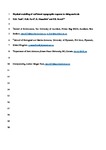Physical modelling of the response of reef islands to sea-level rise
| dc.contributor.author | Tuck, ME | |
| dc.contributor.author | Kench, PS | |
| dc.contributor.author | Ford, MR | |
| dc.contributor.author | Masselink, Gerd | |
| dc.date.accessioned | 2019-10-28T09:27:04Z | |
| dc.date.available | 2019-10-28T09:27:04Z | |
| dc.date.issued | 2019-09-01 | |
| dc.identifier.issn | 0091-7613 | |
| dc.identifier.issn | 1943-2682 | |
| dc.identifier.uri | http://hdl.handle.net/10026.1/15075 | |
| dc.description.abstract |
<jats:title>Abstract</jats:title> <jats:p>Sea-level rise and increased storminess are expected to destabilize low-lying reef islands formed on coral reef platforms, and increased flooding is expected to render them uninhabitable within the coming decades. Such projections are founded on the assumption that islands are geologically static landforms that will simply drown as sea-level rises. Here, we present evidence from physical model experiments of a reef island that demonstrates islands have the capability to morphodynamically respond to rising sea level through island accretion. Challenging outputs from existing models based on the assumption that islands are geomorphologically inert, results demonstrate that islands not only move laterally on reef platforms, but overwash processes provide a mechanism to build and maintain the freeboard of islands above sea level. Implications of island building are profound, as it will offset existing scenarios of dramatic increases in island flooding. Future predictive models must include the morphodynamic behavior of islands to better resolve flood impacts and future island vulnerability.</jats:p> | |
| dc.format.extent | 803-806 | |
| dc.language | en | |
| dc.language.iso | en | |
| dc.publisher | Geological Society of America | |
| dc.subject | 13 Climate Action | |
| dc.title | Physical modelling of the response of reef islands to sea-level rise | |
| dc.type | journal-article | |
| dc.type | Journal Article | |
| plymouth.author-url | https://www.webofscience.com/api/gateway?GWVersion=2&SrcApp=PARTNER_APP&SrcAuth=LinksAMR&KeyUT=WOS:000483606500004&DestLinkType=FullRecord&DestApp=ALL_WOS&UsrCustomerID=11bb513d99f797142bcfeffcc58ea008 | |
| plymouth.issue | 9 | |
| plymouth.volume | 47 | |
| plymouth.publication-status | Published | |
| plymouth.journal | Geology | |
| dc.identifier.doi | 10.1130/g46362.1 | |
| plymouth.organisational-group | /Plymouth | |
| plymouth.organisational-group | /Plymouth/Faculty of Science and Engineering | |
| plymouth.organisational-group | /Plymouth/Faculty of Science and Engineering/School of Biological and Marine Sciences | |
| plymouth.organisational-group | /Plymouth/REF 2021 Researchers by UoA | |
| plymouth.organisational-group | /Plymouth/REF 2021 Researchers by UoA/UoA07 Earth Systems and Environmental Sciences | |
| plymouth.organisational-group | /Plymouth/Research Groups | |
| plymouth.organisational-group | /Plymouth/Research Groups/Marine Institute | |
| plymouth.organisational-group | /Plymouth/Users by role | |
| plymouth.organisational-group | /Plymouth/Users by role/Academics | |
| plymouth.organisational-group | /Plymouth/Users by role/Researchers in ResearchFish submission | |
| dcterms.dateAccepted | 2019-05-27 | |
| dc.rights.embargodate | 2020-7-4 | |
| dc.identifier.eissn | 1943-2682 | |
| dc.rights.embargoperiod | Not known | |
| rioxxterms.versionofrecord | 10.1130/g46362.1 | |
| rioxxterms.licenseref.uri | http://www.rioxx.net/licenses/all-rights-reserved | |
| rioxxterms.licenseref.startdate | 2019-09-01 | |
| rioxxterms.type | Journal Article/Review |


